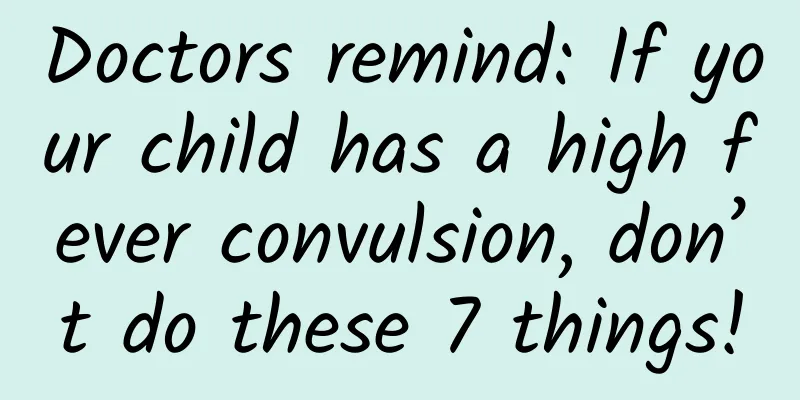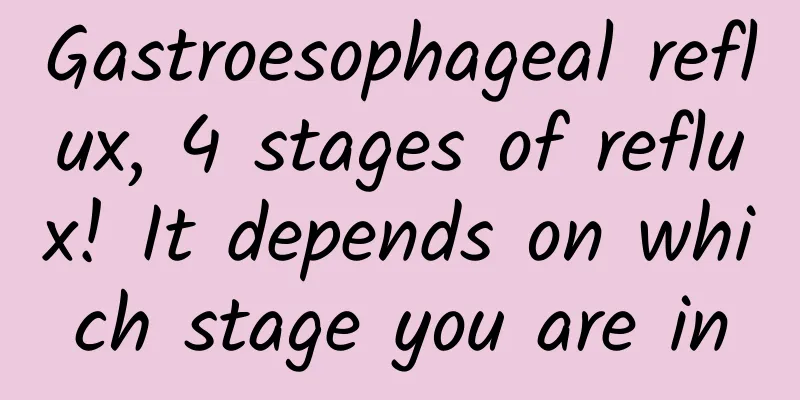Doctors remind: If your child has a high fever convulsion, don’t do these 7 things!

|
In the past two weeks, influenza A virus infection (referred to as H1N1) has been on the rise, and many children have unfortunately been infected. One of the symptoms of H1N1 is high fever, and a child's body temperature may rise rapidly. There are also reports online of children experiencing emergency convulsions due to high fever. Parents are worried about this, fearing that their children will have convulsions and other symptoms if they are infected with influenza A. Let's learn about the relevant knowledge and take the correct response measures to help parents better deal with this emergency. What is a febrile seizure (febrile seizure)? Febrile convulsion, the medical term is febrile convulsion (FS), which is caused by high fever, infection, vaccination and genetics, and convulsions occur in the early stage of fever or the period of rapid temperature rise. At the same time, central nervous system infection and any other acute disease that may cause convulsions need to be ruled out, and there is no history of afebrile convulsions in the past. Typical symptoms of febrile seizures are: During a seizure (commonly known as a "convulsion"), the patient loses consciousness completely, stares, squints or rolls up, tilts the head back, and has tonic or clonic twitching of the facial muscles and limbs, respiratory arrest or even cyanosis, and drowsiness and fatigue after the seizure. Benign seizures are more likely to cause a quick recovery of consciousness after a seizure. Seizures that last more than 15 to 30 minutes or occur frequently indicate a complex or serious condition. Although it sounds worrying, most febrile convulsions are benign and will stop on their own within 3 to 4 minutes on average. They will not cause long-term harm to children, let alone brain damage, and care should be taken to avoid overtreatment. Infection and high fever are both common risk factors for seizures. In a study in Hong Kong, influenza A virus was the most commonly isolated virus in children with febrile seizures, accounting for 20%. Secondly, the fever caused by influenza A virus is usually more severe, and the body temperature can quickly rise to above 39°C, which can easily cause seizures. However, it is worth noting that not all children infected with influenza A will have febrile seizures. In addition to infection and high fever, age and genetic factors can also affect the occurrence of seizures. Copyright images in the gallery. Reprinting and using them may lead to copyright disputes. How to identify and deal with it urgently Febrile seizure? Once parents discover that their child has convulsions during high fever, they should quickly do the following: ✅ Ensure safety: Place your child on a flat surface, such as a bed, sofa or floor (lay a coat on him/her when it is cold). Keep the surrounding area as clear as possible to avoid any furniture or hard objects that may cause secondary injuries. ✅Unbutton the collar: Unbutton the child's collar to ensure unobstructed breathing, which can prevent the child from having difficulty breathing due to tight clothing. The child can lie on his side to avoid vomit or saliva from being accidentally inhaled into the trachea. ✅ Observe calmly and time: Febrile convulsions usually last from a few seconds to a few minutes, and 80% of children will stop convulsing within 5 minutes. Stay calm and record the time of the attack, such as recording a video on your phone, and provide it to the doctor to help judge the condition. ✅Call 120 or seek medical attention: If the child's convulsion lasts for more than 5 minutes, or there is no sign of relief after observing the convulsion for 3-4 minutes, or the situation exceeds the parents' own knowledge of disease care and treatment, you should immediately call 120 emergency number or send the child to the hospital as soon as possible. You need to avoid driving in a panic to ensure safety. It is best to let the child lie flat in the back seat of the car to avoid secondary injuries. Dealing with seizures These mistakes should be avoided When dealing with a seizure, there are some common mistakes to avoid to keep your child safe and prevent the situation from getting worse. Here are some common mistakes to avoid: ❌Give antipyretics to children who are convulsing ❌Use ice water/bag to cool down the convulsing child ❌Forcibly hold down the child’s body or limbs ❌Put your fingers or objects in your child’s mouth ❌Pinch the Ren Zhong point, prick the area to let blood, pat, massage, etc. to stimulate the child's body ❌Hurry and move the child ❌ Take antipyretics as a preventive measure during illness (antipyretic treatment is not effective in preventing febrile seizures) These measures will not shorten the duration of convulsions, nor change the child's prognosis, and may even cause unnecessary secondary harm. Flu Season How to prevent it? Febrile seizures caused by influenza A are usually benign, and it is important for parents to know how to respond to this emergency. Although convulsions are worrying, in most cases they will not cause long-term effects on children's health. During the flu season, prevention of influenza requires blocking contact, droplet and airborne transmission: Wash your hands frequently with soap. Stay away from patients with respiratory infections, avoid crowded places, and use an N95 mask when necessary. Sick family members take the initiative to wear masks. Keep windows open at home for adequate ventilation. The most important thing: Get a flu shot every year. Before or during flu season, children over 6 months of age who haven’t been vaccinated are recommended to get the current year’s vaccine, regardless of whether they’ve had flu before. If your child isn’t suitable for a flu shot, family members should also get the flu shot to help reduce the risk of spreading the virus in the home. In general, parents should pay close attention to their children's health during the flu season. For children (< 5 years old) who are at high risk of influenza and convulsions, if they have fever + flu-like symptoms (cough, sore throat, nasal congestion, runny nose, shortness of breath, myalgia), it is recommended to see a doctor or consult a doctor to obtain appropriate treatment and care plans. References [1] Huang Guoying, Sun Kun, Luo Xiaoping. Pediatrics[M]. 10th edition. Beijing: People's Medical Publishing House, 2024. [2] John J Millichap. Treatment and prognosis of febrile seizures. UpToDate Clinical Advisor. https://www.uptodate.com/contents/zh-Hans/treatment-and-prognosis-of-febrile-seizures. (Accessed on Feb 20, 2024). Planning and production Author: Fan Yunzhu Hangzhou Ho Yun Chia Hospital Nha Trang Clinic Reviewer: Zhao Wei, Chief Physician, Department of Neurology, Tianjin University TEDA Hospital Planning丨Lin Lin Editor: Yang Yaping Proofread by Xu Lai and Lin Lin |
<<: How to prevent high blood pressure, nursing measures for high blood pressure
>>: Norovirus Prevention Guide
Recommend
What is the reason for the ceiling cracking? How to prevent the ceiling from cracking
We all know that ceiling is a common decoration s...
What is cervical erosion repair surgery?
Cervical erosion is a very common gynecological d...
Why is it itchy down there?
In daily life, many female friends may not pay at...
Wormwood fumigation for gynecology
Gynecological diseases are relatively common, and...
Does irregular menstrual cycle affect pregnancy?
The menstrual cycle is a female's physiologic...
Can I eat pears during early pregnancy?
In supermarkets or some vegetable markets, we can...
I drank a bottle of beer during early pregnancy
There is alcohol in beer. Don't think that ma...
What is cheese? Is there a difference between cheese slices and cheese slices?
Cheese is a traditional food of Mongolians and Ka...
Reasons for missing menstruation for two or three months
In daily life, both girls and married women will ...
Cost of freezing eggs
Many people have heard that women should have chi...
Food Safety | Save food and cultivate virtue through thrift
**Every meal should be appreciated as it is not e...
How can I speed up labor pains after seeing blood?
If a pregnant woman has spotting in the late stag...
How many days does ovulation occur when the leucorrhea is stringy?
There are many situations in which girls have abn...
High blood sugar after childbirth
Many people worry about their high blood sugar, b...
Do women still ovulate after menopause? The truth is this
Many women will ask a question online: they have ...









